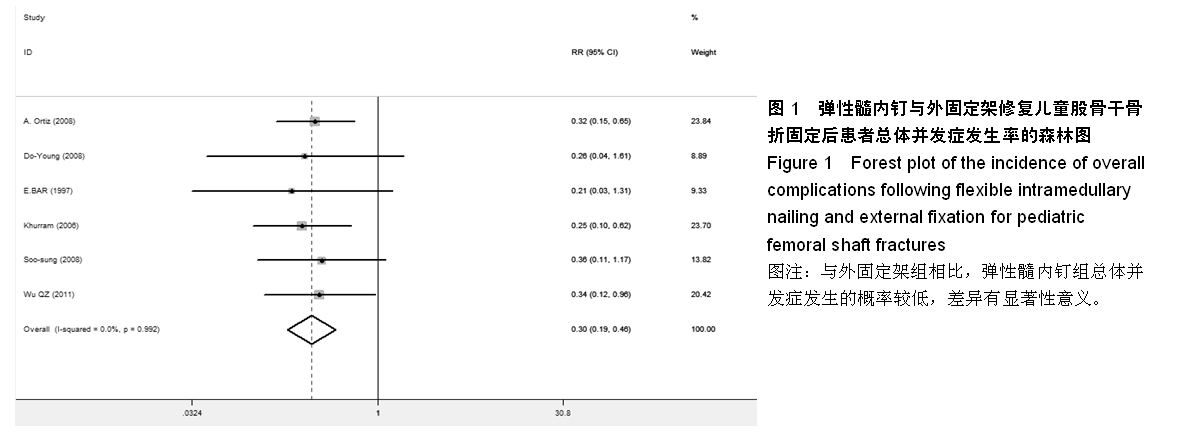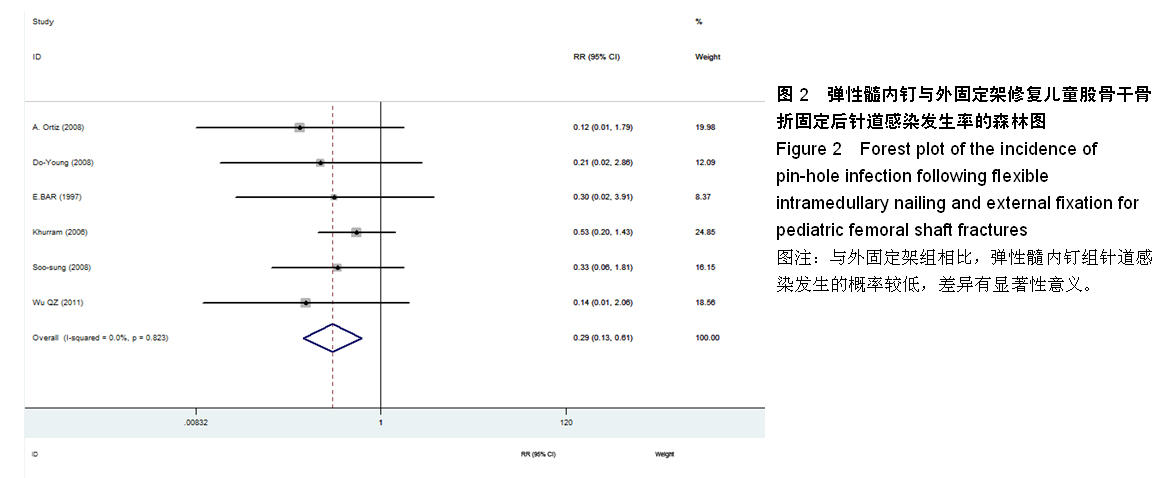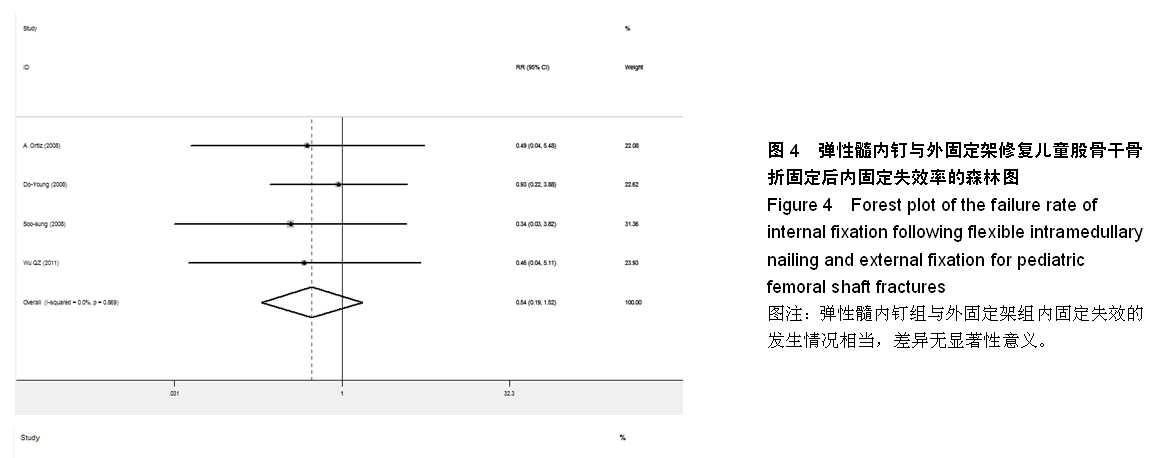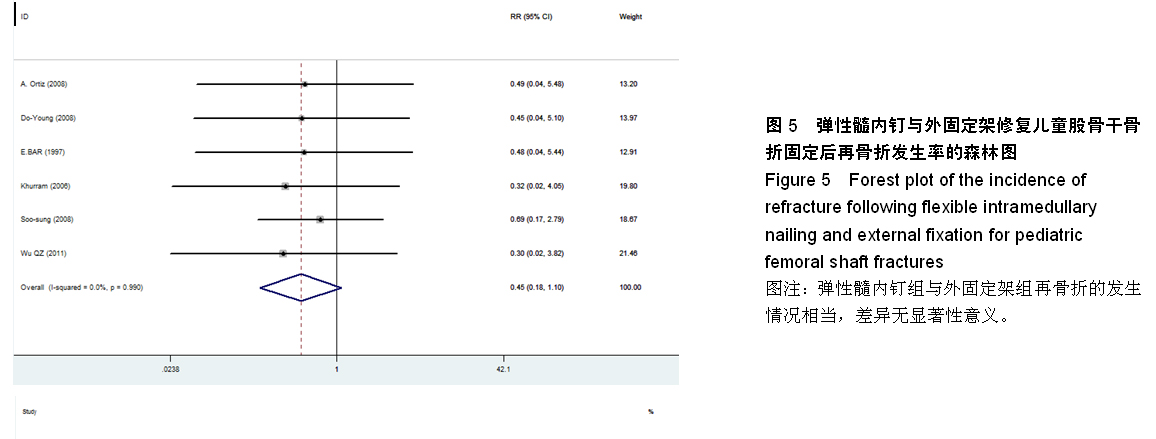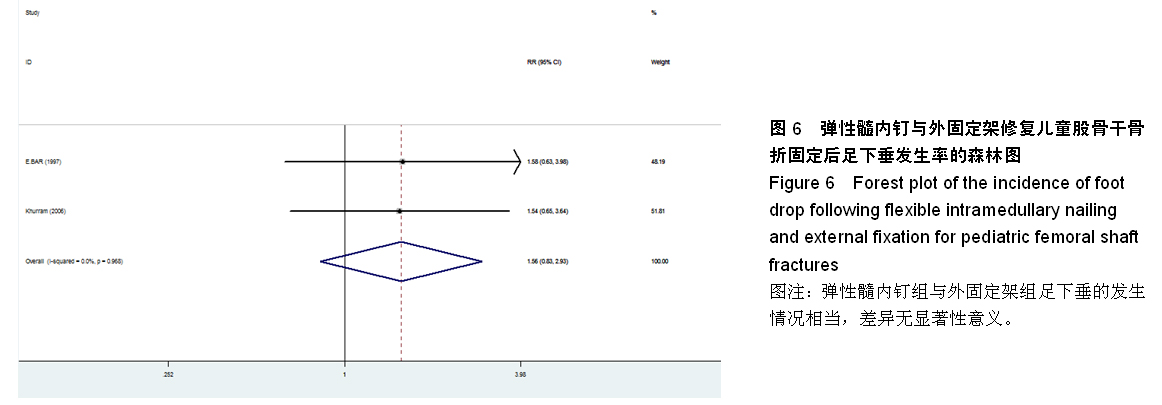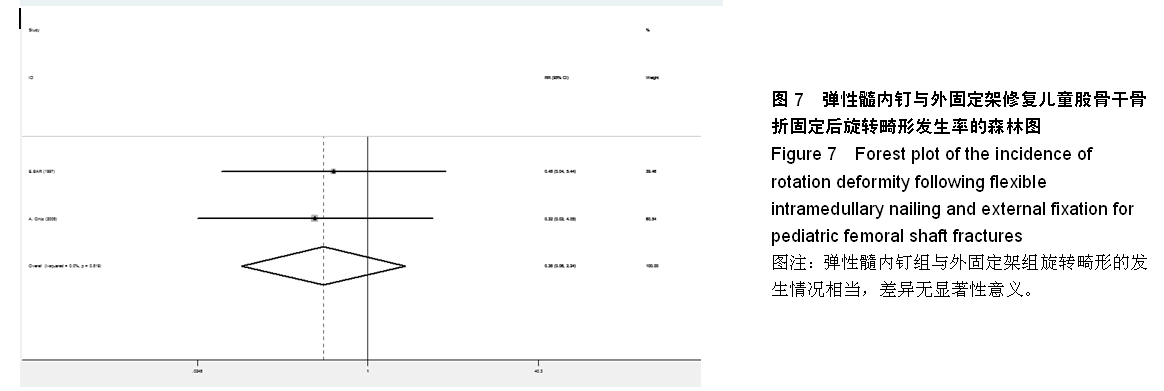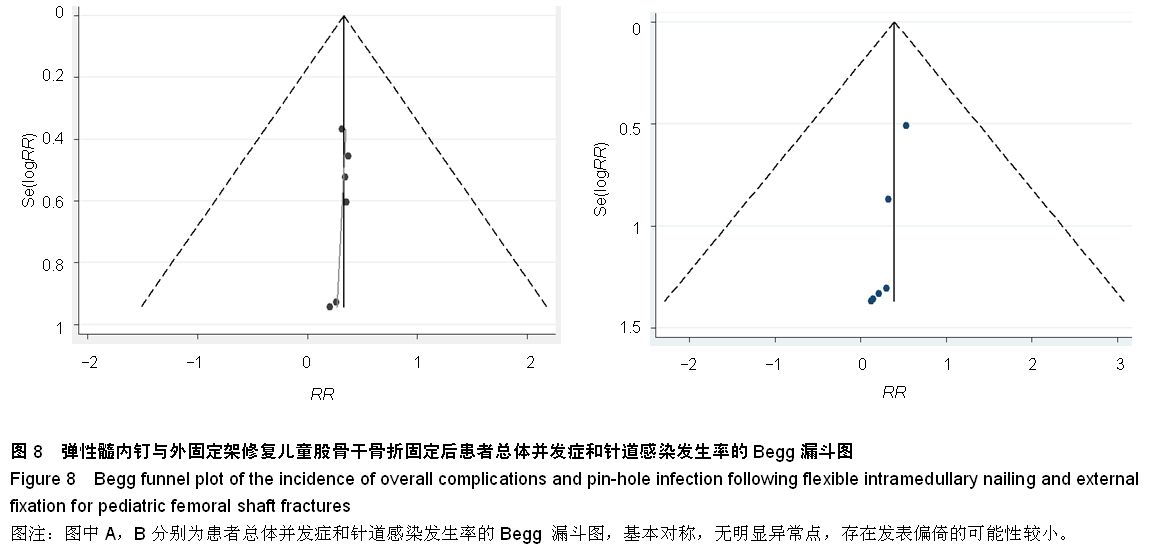| [1] 吴素英.髓内钉置入治疗儿童股骨干骨折:来源于SCI数据库的文献分析[J].中国组织工程研究,2012,16(30):5670-5675.
[2] Huber H,André G,Rumeau F,et al.Flexible intramedullary nailing for distal femoral fractures in patients with myopathies.J Child Orthop. 2012;6(2):119-123.
[3] Wani MM,Dar RA,Latoo IA,et al.External fixation of pediatric femoral shaft fractures: a consecutive study based on 45 fractures.J Pediatr Orthop B. 2013;22(6): 563-570.
[4] Nascimento FP, Santili C, Akkari M, et al. Short hospitalization period with elastic stable intramedullary nails in the treatment of femoral shaft fractures in school children. J Child Orthop. 2010;4:53-60.
[5] Jadad RA, Moore RA, Carroll D, et al. Assessing the quality of reports of randomized clinical trials: is blinding necessary? Control Clin Trails. 1996;17:1-12.
[6] Ortiz-Espada A. Elastic nailing vs. external fixation as methods to address pediatric femoral fractures: a review of 40 cases.J Trauma. 2009;53(2):106-112.
[7] Kim DY, Shin SR, Jeong US, et al. Comparison of Flexible Intramedullary Nailing with External Fixation in Pediatric Femoral Shaft Fractures. J Korean Orthop Soc. 2008; 43(1): 30-35.
[8] Baron E, Sagiv S, Porat S. External fixation or flexible intramedullary nailing for femoral shaft fractures in children. J Bone Joint Surg Br. 1997;79-B(6):975-978.
[9] Barlas K, Beg H. Flexible intramedullary nailing versus external fixation of paediatric femoral fractures.Acta Orthop Belg. 2006;72(2):159-163.
[10] Park SS, Park JB. Comparison of Flexible Intramedullary Nailing with External Fixation for Treating Pediatric Femoral Shaft Fractures.J Korean Orthop Soc.2008; 43(6): 665-671.
[11] Wu QZ,Zhang J,Lan SH.Clinical outcomes of elastic intramedullary nail fixation and external fixation for the treatment of pediatric femoral shaft fractures.Zhongguo Gu Shang. 2011;24(2):146-148.
[12] 刘晓强,陈宗雄,王万宗,等.成人肱骨干重建钢板置入治疗儿童股骨干骨折32例:随访分析[J].中国组织工程研究与临床康复, 2010,14(17):3193-3196.
[13] Leu D, Sargent MC, Ain MC, et al. Spica casting for pediatric femoral fractures: a prospective, randomized controlled study of single-leg versus double-leg spica casts. J Bone Joint Surg Am. 2012;94:1259-1264.
[14] Rush JK, Kelly DM, Sawyer JR, et al. Treatment of pediatric femur fractures with the Pavlik harness: Multiyear clinical and radiographic outcomes. J Pediatr Orthop. 2013;33: 614-617.
[15] Heyworth BE, Suppan CA, Kramer DE, et al. Management of pediatric diaphyseal femur fractures. Curr Rev Musculoskelet Med. 2012.[Epub ahead of print].
[16] 王军强,王满宜.骨折的生物学固定[J].中华外科杂志,2002, 40(7): 543-546.
[17] Saseendar S, Menon J, Patro DK. Treatment of femoral fractures in children: is titanium elastic nailing an improvement over hip spica casting? J Child Orthop. 2010;4(3):245-251.
[18] 王华明,陈志龙,李卫平等.弹性髓内钉治疗儿童股骨干骨折钢板固定失效病例[J].中国组织工程研究,2013,17(26): 4819- 4825.
[19] Palmer RH. Biological osteosynthesis. Vet Clin North Am Small Anim Pract. 1999;29:1171-1185.
[20] Aslani H, Tabrizi A, Sadighi A, et al. Treatment of open pediatric tibial fractures by external fixation versus flexible intramedullary nailing: a comparative study. Arch Trauma Res. 2013;2(3):108-112.
[21] 杨明兴,池永龙,王春,等.弹性髓内钉治疗稳定和不稳定性儿童股骨干骨折的病例对照研究[J].中国骨伤,2012,25(2):116-119.
[22] 周永顶,索鹏,王浩杰,等.弹性髓骨钉治疗儿童股骨干骨折的疗效[J].广东医学,2012,33(18):2869-2869.
[23] Krettek C. Forword: concepts of minimally invasive plate osteosynthesis. Injury. 1997;28(Suppl ): A1-2.
[24] Narayanan UG, Phillips JH. Flexibility in fixation: an update on femur fractures in children. J Pediatr Orthop. 2012;32(suppl 1):S32-S39.
[25] 陈日勇,刘运纪.弹性髓内钉固定治疗儿童股骨干骨折[J].实用骨科杂志,2012,18(3):264-265.
[26] 蒋学军,李勇.皮牵引与钛合金弹性钉治疗儿童股骨干骨折的疗效比较[J].山东医药,2014,54(4):101-102.
[27] 钟俊,杨淮河,张军,等.弹性髓内钉微创治疗儿童股骨干骨折的疗效[J].南昌大学学报(医学版),2013,53(10):78-79,82.
[28] Nascimento FP, Santili C, Akkari M,et al. Flexible intramedullary nails with traction versus plaster cast for treating femoral shaft fractures in children: comparative retrospective study.Sao Paulo Med J. 2013;131(1):5-12.
[29] Volpon JB,Perina MM,Okubo R,et al. Biomechanical performance of flexible intramedullary nails with end caps tested in distal segmental defects of pediatric femur models.J Pediatr Orthop.2012;32(5):461-466.
[30] Nascimento FP, Santili C, Akkari M, et al. Short hospitalization period with elastic stable intramedullary nails in the treatment of femoral shaft fractures in school children. J Child Orthop. 2010;4(1):53-60.
[31] Nisar A, Bhosale A, Madan SS, et al. Complications of Elastic Stable Intramedullary Nailing for treating paediatric long bone fractures. J Orthop. 2013;10(1):17-24.
[32] Lascombes P, Nespola A, Poircuitte JM, et al.Early complications with flexible intramedullary nailing in childhood fracture: 100 cases managed with precurved tip and shaft nails. Orthop Traumatol Surg Res. 2012;98:369-375.
[33] 付胜华,覃文报,余永壮,等.弹性髓内钉内固定和外固定支架治疗儿童股骨干骨折的比较[J].中国现代医生,2012,50(23): 148-149.
[34] 孙辽军,杨杰,余贤斌,等.小切口复位与闭合复位弹性钉治疗儿童股骨干骨折的比较研究[J].中华小儿外科杂志,2013,34(9): 673-677.
[35] 杨宏锟,张仲子,赵烽,等.外固定架治疗儿童股骨干骨折疗效分析[J].医药前沿,2013,35(26):225-226.
[36] 崔建,张寰.单臂外固定架在治疗儿童股骨干骨折的临床应用观察[J].徐州医学院学报,2014,34(11):760-761.
[37] Wani MM, Dar RA, Latoo IA, et al.External fixation of pediatric femoral shaft fractures: a consecutive study based on 45 fractures.J Pediatr Orthop B. 2013;22(6):563-570.
[38] Aronson J, Tursky EA. External fixation of femur fracture in children. J Pediatr Orthop. 1992;12:157-163.
[39] Kong H, Sabharwal S. External fixation for closed pediatric femoral shaft fractures: where are we now?Clin Orthop Relat Res. 2014;472(12):3814-3822.
[40] EI Hayek T,Daher AA,Meouchy W, et al. External fixators in the treatment of fractures in children.J Pediatr Orthop B. 2004; 13:103-109.
|

